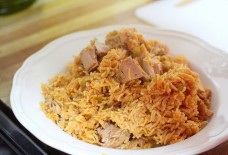A Graffiti Artist Is Remixing an Ancient Art Form to Tell the Real Story of Beirut
Britni Danielle
Takepart
Unlike many budding artists, Yazan Halwani wasn’t drawn to art because he had a burning desire to express himself. Instead, the 22-year-old muralist was inspired to pick up his paintbrush about eight years ago for a completely different reason.
“I was not a person that was obsessed with painting or drawing,” he tells TakePart. “But I used to see these walls in the city, and I used to find it very sad.” Halwani, a native of Beirut, says the buildings in his hometown were covered with remnants of past elections—from spray-painted images of politicians to political graffiti—and riddled with bullet holes from Lebanon’s 15-year civil war.
The amount of damage that remained throughout Beirut after the war ended in 1990 compelled Halwani to stop walking past the scarred walls and start creating something that would hark back to Lebanese culture and inspire his peers to find common ground in their shared experience. Choosing to express himself through graffiti, Halwani uses traditional Arabic calligraphy to create portraits that aim to show what he says is the “true identity” of the city.
Today, Halwani is one of Beirut’s most promising painters. His story is captured in the premiere episode of Resilient Cities, a five-part docuseries airing on Pivot (TakePart’s sister network) that delves into the underground art scene in cities around the world that have experienced major trauma. The full episode is available to watch below.
Halwani’s path to success was one he forged for himself. “Beirut is a city that has a lot of culture, but everything is done at the independent level because the politicians started to weaken the cultural infrastructure and strengthen the political identity,” he says.
According to Halwani, Lebanon’s artists, dancers, and creatives aren’t offered any backing from the government because leaders are more invested in pushing politics than nurturing the country’s bustling art scene, a move that fueled his desire to paint.
“Having no arts infrastructure creates a very interesting scene. Art is often institutionalized, but when I started doing what I do, it was not like I had the objective of going to art museums or [showing] in a gallery, or being in that important role in the city,” he explains. “Things are very young in the city, and I find this really fun because there’s no preconception of what Arab street art should be.”
Halwani also doesn’t want to imitate what he sees in the West. “As an artist, I do feel an obligation to preserve our own culture,” he says in Resilient Cities.
To the outside observer, Halwani’s use of Arabic calligraphy may seem in keeping with Lebanon’s geographical location in the Middle East, but his decision to quite literally flip the script to create something that runs counter to the original intent is particularly innovative.
“This is kind of blasphemous when it comes to the rules of Arabic calligraphy, because it was created exactly to run away from configuration,” he says. Instead of sticking to the precepts and letting the words float formlessly across the page or canvas, Halwani bucks centuries of tradition to mold the beautiful script into images of prominent Lebanese figures.
“What I try to do is create from this form of abstraction a portrait of a cultural figure that shows an Arab identity,” he says.
Some find Halwani’s mission to “re-create a sense of [Arabic] identity” to be a bold political statement, but he doesn’t see it that way.
“I don’t have a problem discussing politics, but politics is not the main goal of my work,” he explains. “For example, when I paint something on the street, I might not reference politics at all. I’ll paint a famous singer that reminds people of the culture of Beirut in the 1970s, but I’ll do it on a street that maybe has a certain political presence without seeking permission from them. By doing so, maybe the message is, we don’t care about this political identity, we care about the culture.”
For Halwani, who bounces between Lebanon and the United Arab Emirates, highlighting Beirut’s people and their stories is the most important part of his work.
“It’s not my goal to be subversive just to be subversive,” he says. “What I try to do is to create a mural that’s good, and by that, I mean it reflects the true identity of the city.”
Source: www.takepart.com



